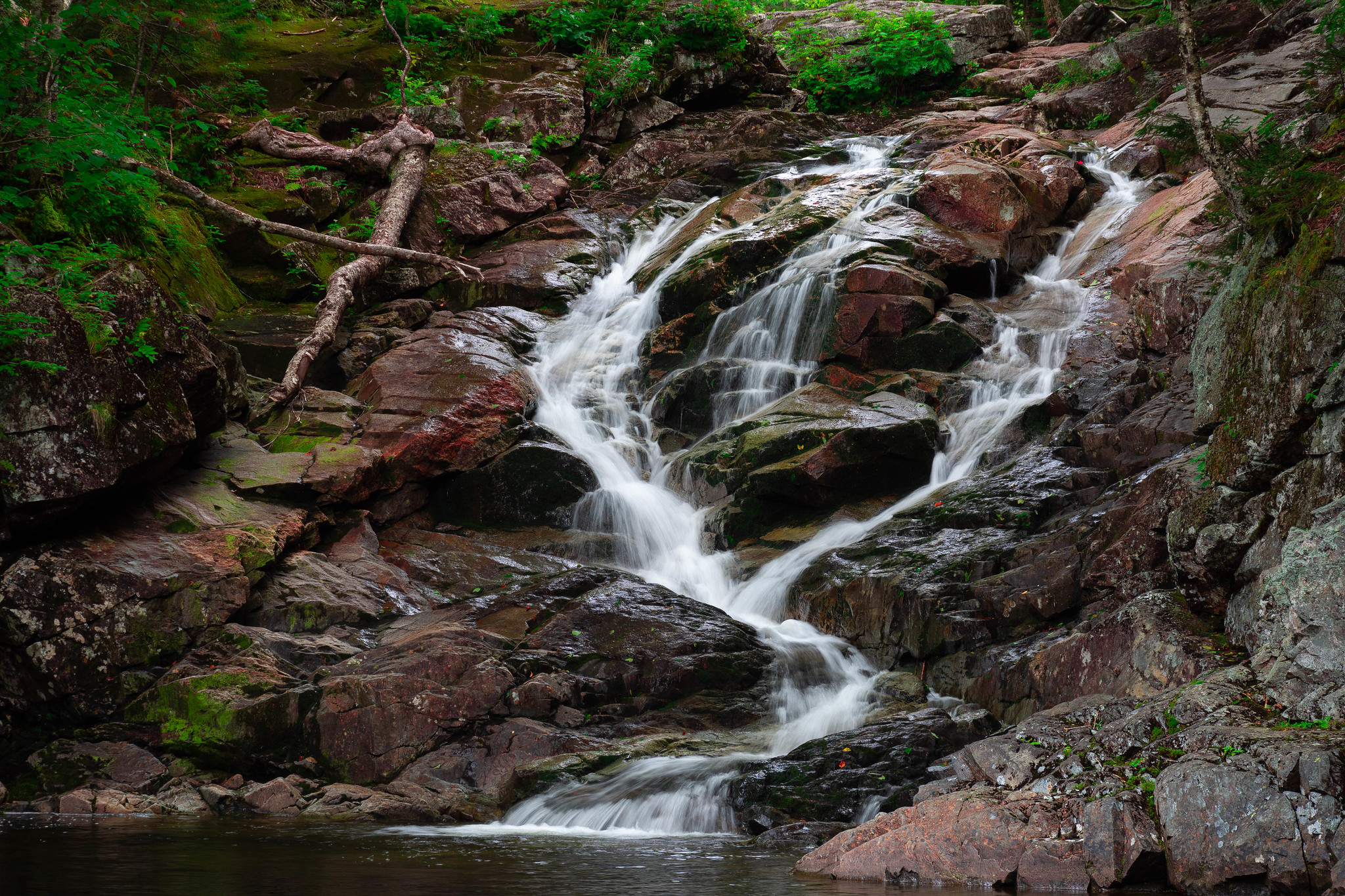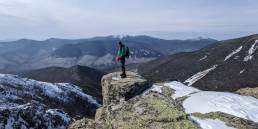Day hiking in New Hampshire’s White Mountains is super popular, but overnighting in the same terrain is even better. If the mountains are calling for you to spend the night but you’re new to backpacking, don’t despair—there are plenty of excellent backpacking trips in the White Mountain National Forest that are well-suited for beginners.

1. Sawyer Pond
Camping next to a 40+ acre pristine backcountry lake with breath-taking mountain views accessed by a short—three miles round-trip—hike makes Sawyer Pond an extremely popular destination for beginners. Pack your fishing pole, Sawyer Pond is also a favorite of backcountry anglers, as it’s annually stocked with brook trout (so is the 11-acre Little Sawyer Pond, which is just a short hike on a herd path that leaves from the camping area).
Sawyer Pond is most easily accessed via Sawyer River Road, just a few miles outside of the village of Bartlett. Be aware that Sawyer River Road closes in the winter—a gate restricts vehicle access generally from mid-November to mid-May. If the gate is locked, ambitious backpackers can hike the road, which adds about four miles of approach from the Kancamagus Highway, a roughly 11-mile round trip.
Finding Sawyer Pond is easy and even beginners with a questionable sense of direction should have no issues arriving at their overnight destination. The Sawyer River Trail is well distinguished, easy to follow, and periodically marked with yellow blazes. After approximately 1.5 miles, backpackers will encounter a sign directing them to the Sawyer Pond Shelter and Tentsite.
The Sawyer Pond Shelter and Tentsite feature a shelter that sleeps six as well as six tent platforms. Each campsite has its own fire ring and there are two outhouses. Another thing to love about Sawyer Pond Shelter and Tentsite is that it’s free. Camping is first-come, first-serve, and there are dispersed camping options a quarter-mile from the established camping area.

2. 13 Falls
Beginning backpackers love this 16-mile out-and-back trip into the heart of the Pemi. The route is relatively flat, easy to navigate, and has several options for add-ons, with spur trails leading to everything from waterfalls to 4,000-foot summits that create innumerable ways to tailor this trip to hikers of all abilities and energy levels. Another factor that makes this a favorite is the abundant amount of water sources—you’ll never worry about when the next chance to fill a water bottle will come, or lack of a place to soak your feet or take a dip.
A trip to 13 Falls begins on the Lincoln Woods Trailhead, located off of the Kancamagus Highway just outside of Lincoln. There is a $5 day-use fee to park your car at the trailhead. You can also purchase an annual pass for $30, which is an economical option if you plan on taking a few backpacking trips or are regularly recreating in the White Mountain National Forest. The Lincoln Woods lot is generally busy and frequently exceeds its 170 car capacity, so getting an early start is recommended.
Getting to 13 Falls Tentsite is straightforward: Backpackers start on the wide and often bustling Lincoln Woods Trail, following the path of an old logging railway line and hugging the side of the Pemigewasset River for its full, roughly three-mile length. At the terminus of the Lincoln Woods Trail, backpackers pick up the Franconia Falls Trail, following it past numerous small waterfalls and enticing pools to the 13 Falls Tentsite.
13 Falls, named after an old logging camp—Camp 13—features nine tent pads, a bear box, a composting toilet, and a dishwashing area. These amenities come at a cost; From Memorial Day to Columbus Day, it’s $15 per night to stay at the tentsite.
From 13 Falls, 4,000-footers like Garfield and Galehead are accessible add-ons for energetic beginners who are looking to keep going or those who are staying multiple nights at the tentsite. Of course, doing these add-ons requires leaving the wonderful, must-visit waterfalls that are in close proximity to the camp.

3. Kinsman Pond
Quiet, high-elevation (3,750 feet!) camping next to an alpine lake and easy access to the summits of two New Hampshire 4,000-footers make an out-and-back backpacking trip to Kinsman Pond Shelter and tentsites a well-liked trip of beginners and seasoned backpackers alike.
The easiest way to reach Kinsman Pond is from the Lafayette Place Parking Area, following the yellow blazes of the well-trod Lonesome Lake Trail, gaining roughly 1,000 feet in a mile and a half. Plan to get an early start—this is one of the busiest spots in the Whites, and parking has been an issue in recent years. Break at the Lonesome Lake Hut (the AMC’s bustling hut), have a snack, and take in the great view of the glacial lake and Franconia Ridge. When you’re ready to leave the hut behind, head up the Fishin’ Jimmy Trail for approximately two rugged miles, climbing another 1,000 feet.
The Kinsman Pond backpacking area has a shelter that can accommodate 12 people, three single tent platforms, and one group platform. The Kinsman Pond camping area also has an outhouse, dishwashing area, a bear box, and a great view of North Kinsman towering above. Camping is first-come, first-serve, and costs $15 a night. If the sites are full, there is dispersed camping a fifth of a mile up the trail near Kinsman Junction.
For many new backpackers, just getting to Kinsman Pond is quite an accomplishment, but others may want to drop their heavy packs, grab just the essentials, and pick off the peaks of North and South Kinsman. The summit of North Kinsman sits just a half-mile and 500 feet of elevation above and is home to an all-time lookout ledge while the summit of South Kinsman and its throne-shaped summit cairn is another undulating mile away.

4. Liberty Springs
A point-to-point backpacking hike of Mount Flume and Mount Liberty with an overnight at Liberty Springs Tentsite is the perfect destination for newer beginners anxious to get on classic White Mountain terrain. The trip tags the two southernmost 4,000-foot summits on the iconic Franconia Ridge, both of which deliver interesting above-treeline terrain and incredible views.
The ideal strategy for this trip is to spot a car at the Basin Parking Lot on Route 93N before leaving from the Lincoln Woods Trailhead—the same trailhead that a trip to 13 Falls departs from. Backpackers will pick up the bulk of their mileage on day one of this trip, as they follow the Lincoln Woods Trail for 1.5 easy miles to its connection with the Osseo Trail, which they’ll follow for 4.5 more-difficult miles to the top of Mount Flume.
On the summit of Mount Flume, hikers connect with the Franconia Ridge Trail, which they’ll follow from the bare summit of Mount Flume back into the forest and to the craggy peak of Mount Liberty for 1.5 miles. From the summit of Mount Liberty, the Liberty Tentsite—and its seven single and three double tentpads, outhouse, and dishwashing area—is a little over a mile away, all of which is downhill. Camping is on a first-come, first-serve basis and there is a $15 per person, per night fee between Memorial Day and Columbus Day.
Day two yields an easy day for backpackers, so feel free to sleep in and make a big breakfast. From Liberty Springs, backpackers follow the Liberty Springs Trail as it gently descends over roughly 2.5 miles to the Franconia Notch Recreational Path. From there, your vehicle is just a short walk away.
Backpackers with busy schedules can easily reverse the route too, hiking 2.5 miles from the Basin on day (or evening) one, then spend the bulk of day two hiking up Liberty and Flume and then down the Osseo Trail. This is a great option for folks looking for a quick-hitting wilderness fix or who aren’t able to get two full days free.
Have a favorite backpacking trip for beginners? Leave it in the comments below.
Tim Peck and Doug Martland
Tim and Doug met long ago at the Eastern Mountain Sports in Canton, Massachusetts. Bonding over a love of slick Quincy Quarry granite, White Mountain sufferfests, and scheming up adventures while folding tee-shirts, today Tim and Doug collaborate to write about their favorite outdoor activities and occasionally get nostalgic about tee-shirt tables.
Related Posts
April 12, 2024
Explore Like a Local: The Outdoor Mecca of North Conway, NH
There's a lot to love about this New…
April 3, 2024
5 Things To Do in the Boston Area During Mud Season
Adventure opportunities are abundant…




